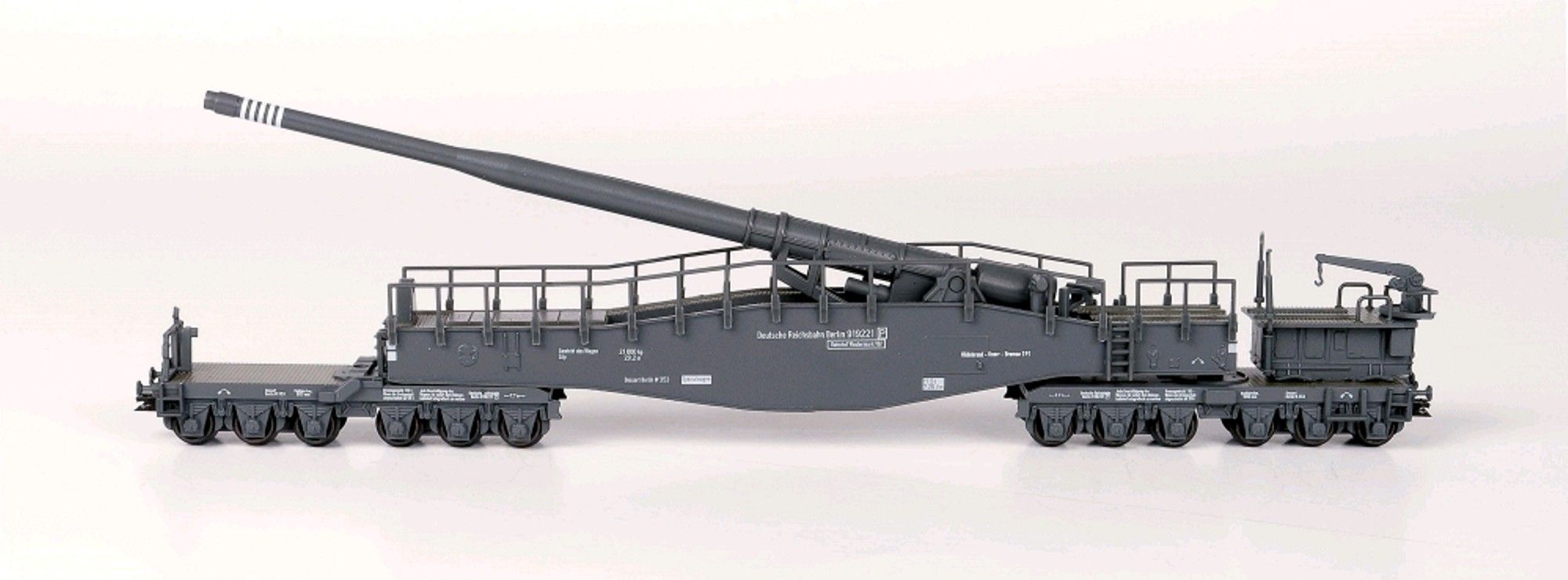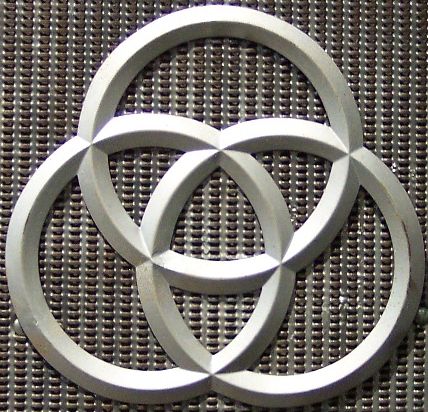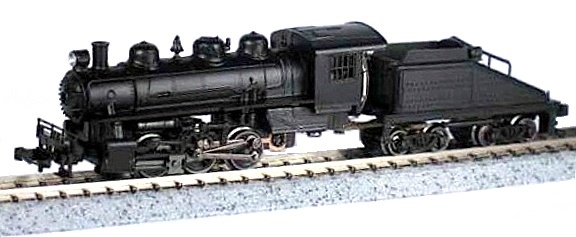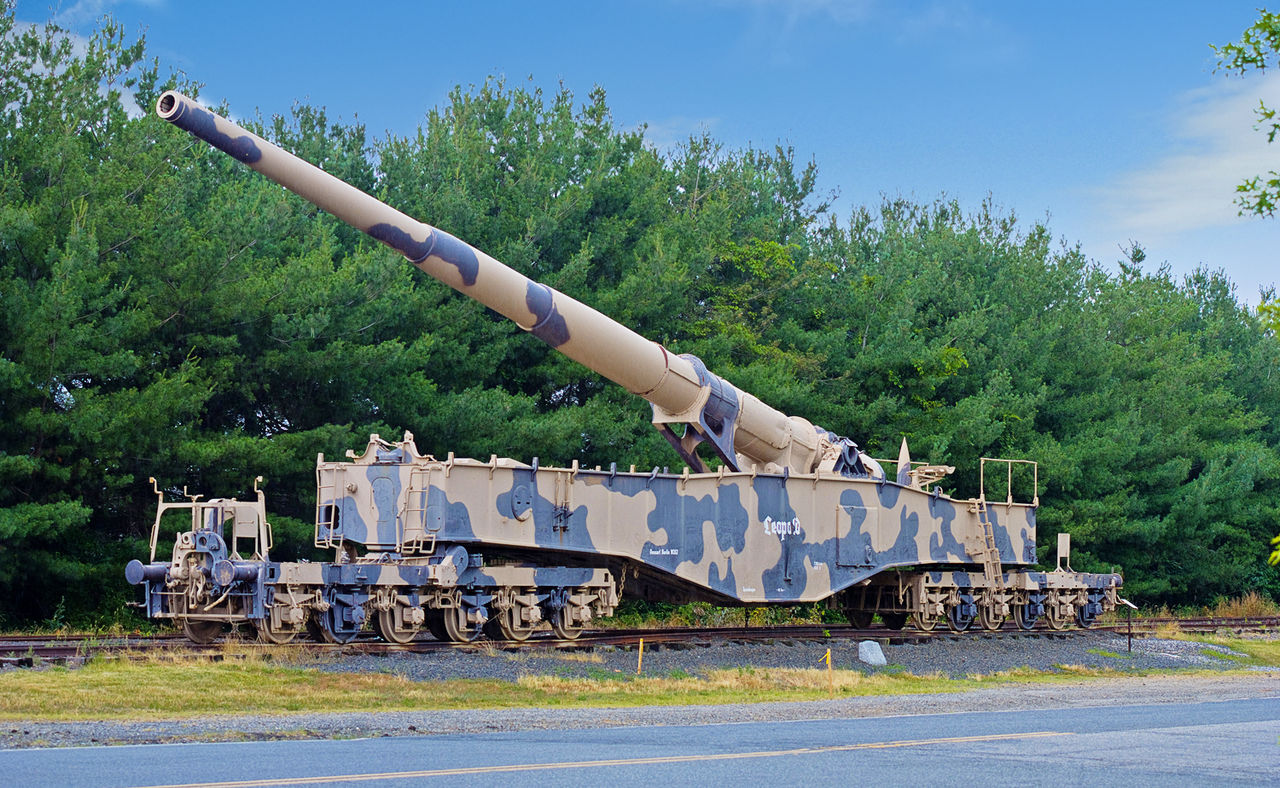Prototype History: Krupp's K5 series were consistent in mounting a 21.5 metres (71 ft) long gun barrel in a fixed mounting with only vertical elevation of the weapon. This gondola was then mounted on a pair of 12-wheel bogies designed to be operated on commercial and military rails built to German standards. This mounting permitted only two degrees of horizontal traverse. The carriage had to be aligned on the rails first, with only minimal fine leveling capable once halted. Hence the gun could only fire at targets tangential to an existing railway track.
To track targets needing greater traverse either a curved length of railway was used with the gun shunted backwards or forwards to aim; a cross-track was laid with the front bogie turned perpendicular to the rest of the gun and moved up and down the cross-track to train the weapon; or for 360 degree traverse, the "Vögele Turntable" could be constructed, consisting of a raised rail section (the "firing bed") carrying the gun, running on a circular track with a central jack to raise the gun during traverse and to take some of the enormous weight.
The main barrel of the K5 is 283 mm (11.1 in) in calibre (caliber), and is rifled with twelve 7 mm (0.28 in) grooves. These were originally 10 mm (0.39 in) deep, but were shallowed to rectify cracking problems.
From Wikipedia
To track targets needing greater traverse either a curved length of railway was used with the gun shunted backwards or forwards to aim; a cross-track was laid with the front bogie turned perpendicular to the rest of the gun and moved up and down the cross-track to train the weapon; or for 360 degree traverse, the "Vögele Turntable" could be constructed, consisting of a raised rail section (the "firing bed") carrying the gun, running on a circular track with a central jack to raise the gun during traverse and to take some of the enormous weight.
The main barrel of the K5 is 283 mm (11.1 in) in calibre (caliber), and is rifled with twelve 7 mm (0.28 in) grooves. These were originally 10 mm (0.39 in) deep, but were shallowed to rectify cracking problems.
From Wikipedia
Road Name History: 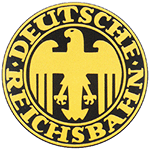 The Deutsche Reichsbahn, also known as the German Reich Railway or the German Imperial Railway, was the name of the German national railway created from the railways of the individual states of the German Empire following the end of World War I.
The Deutsche Reichsbahn, also known as the German Reich Railway or the German Imperial Railway, was the name of the German national railway created from the railways of the individual states of the German Empire following the end of World War I.
The company was founded in 1920 as the Deutsche Reichseisenbahnen when the Weimar Republic, formally known as Deutsches Reich (German Reich, hence the usage of the Reich in the name of the railway), took national control of the German railways, which had previously been run by the German states. In 1924 it was reorganised under the aegis of the Deutsche Reichsbahn-Gesellschaft (DRG), a nominally private railway company, which was 100% owned by the German state. In 1937 the railway was reorganised again as a state authority and given the name Deutsche Reichsbahn (DRB). After the Anschluss in 1938 the DR also took over the Bundesbahn Osterreich (BBO, Federal Railway of Austria).
The East and West German states were founded in 1949. East Germany took over the control of the DR on its territory and continued to use the traditional name Deutsche Reichsbahn, while the railway in West Germany became the Deutsche Bundesbahn (DB, German Federal Railway). The Austrian Osterreichische Bundesbahnen (OBB, Austrian Federal Railways) was founded in 1945, and was given its present name in 1947.
In January 1994, following the German union, the East German Deutsche Reichsbahn merged with the West German Deutsche Bundesbahn to form Germany's new national carrier, Deutsche Bahn AG, technically no longer a government agency but still a 100% state-owned joint stock company.

The company was founded in 1920 as the Deutsche Reichseisenbahnen when the Weimar Republic, formally known as Deutsches Reich (German Reich, hence the usage of the Reich in the name of the railway), took national control of the German railways, which had previously been run by the German states. In 1924 it was reorganised under the aegis of the Deutsche Reichsbahn-Gesellschaft (DRG), a nominally private railway company, which was 100% owned by the German state. In 1937 the railway was reorganised again as a state authority and given the name Deutsche Reichsbahn (DRB). After the Anschluss in 1938 the DR also took over the Bundesbahn Osterreich (BBO, Federal Railway of Austria).
The East and West German states were founded in 1949. East Germany took over the control of the DR on its territory and continued to use the traditional name Deutsche Reichsbahn, while the railway in West Germany became the Deutsche Bundesbahn (DB, German Federal Railway). The Austrian Osterreichische Bundesbahnen (OBB, Austrian Federal Railways) was founded in 1945, and was given its present name in 1947.
In January 1994, following the German union, the East German Deutsche Reichsbahn merged with the West German Deutsche Bundesbahn to form Germany's new national carrier, Deutsche Bahn AG, technically no longer a government agency but still a 100% state-owned joint stock company.
Item created by: nscalemodeler160 on 2016-11-05 19:55:51. Last edited by CNW400 on 2020-09-09 23:16:30
If you see errors or missing data in this entry, please feel free to log in and edit it. Anyone with a Gmail account can log in instantly.
If you see errors or missing data in this entry, please feel free to log in and edit it. Anyone with a Gmail account can log in instantly.


